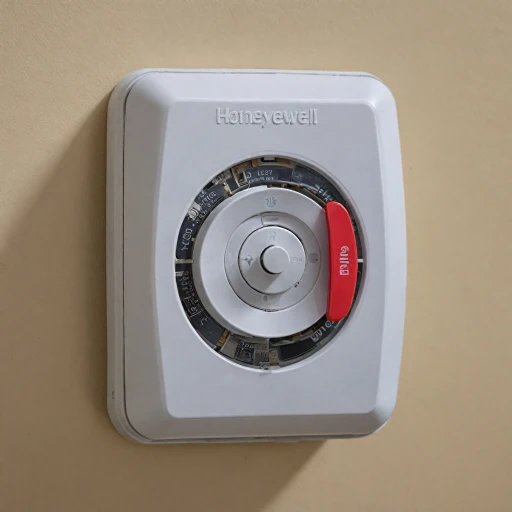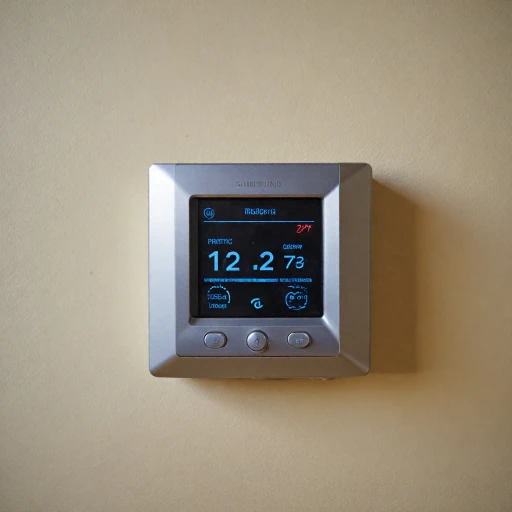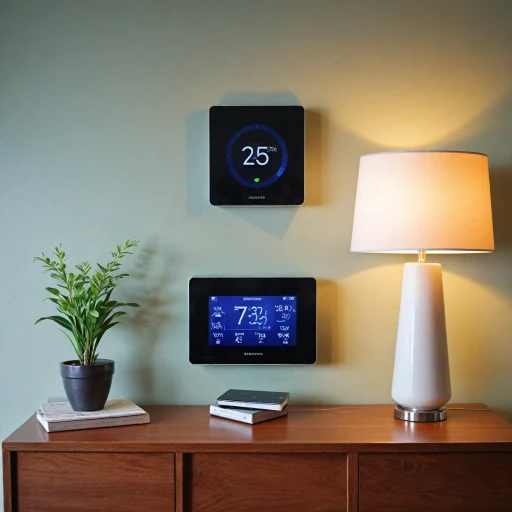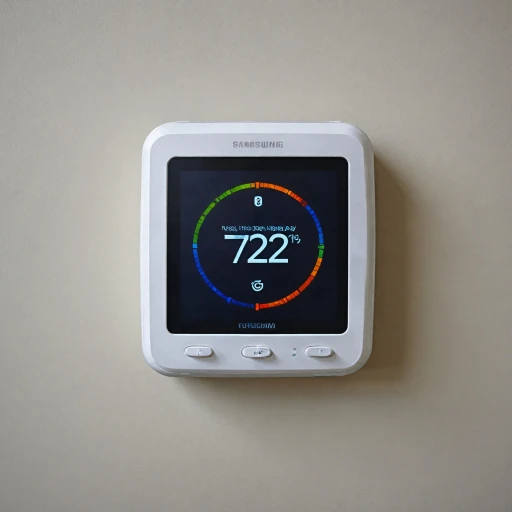
Understanding Remote Temperature Sensors
Unlocking the Potential of Remote Temperature Sensors
Remote temperature sensors have become essential components in the realm of smart home technology. These intelligent devices offer a new level of precision in maintaining optimal indoor temperature, addressing common challenges such as cold spots or inconsistent heating and cooling across different rooms. Remote sensors communicate with your smart thermostat to deliver accurate temperature readings from various parts of your home. This means that rather than relying solely on the thermostat's built-in sensor (often located in a central area), you can achieve more balanced comfort by monitoring multiple locations.- Broad Coverage: Remote temperature sensors provide a wider reach, covering areas that might otherwise be overlooked by the main thermostat. This is particularly beneficial in multi-level homes where temperature variation can be significant.
- Improved Comfort: By placing sensors in frequently used or problematic rooms, such as those prone to being too hot or too cold, you can ensure that these spaces are more consistently comfortable.
- Smart Integration: Many of these sensors connect with your home's Wi-Fi network, allowing you to view and adjust performance through a dedicated app. This connectivity enhances user control and makes it easier to monitor the climate from anywhere.
Benefits of Using Remote Temperature Sensors
Advantages of Integrating Smart Temperature Sensors
When it comes to enhancing your home's climate control, remote temperature sensors for thermostats are game-changers. Here's why integrating these smart sensors is beneficial:
- Improved Comfort: Remote sensors optimize indoor temperature across different rooms, eliminating cold spots and maintaining a consistent climate. This ensures your smart thermostat collaborates effectively with the sensors to deliver unparalleled comfort throughout your living space.
- Precision and Control: With their ability to detect discrepancies in temperature room-by-room, these sensors provide precise data to your smart thermostat. This precision allows it to adjust heating and cooling systems accordingly, enabling efficient energy use and cost savings.
- Remote Access: These smart sensors pair seamlessly with smartphone apps, giving you remote control of your home environment. Whether you're lounging at home or vacationing miles away, you can monitor and adjust settings with ease.
- Long Battery Life: Many sensor products boast a durable battery life ensuring long-term usage without constant replacements, enhancing overall convenience.
- Collective Integration: When coupled with other smart home devices, these sensors offer a comprehensive approach to home automation. Systems like the ecobee capitalize on sensor capabilities, combining utility with modern technology.
Smart thermostats are advancing rapidly, and remote sensors are a key component. They're not just about immediate benefits but are shaping the future of temperature control technology. For more detailed information, check out this comprehensive guide on understanding temperature sensors for Nest thermostats.
Installation and Compatibility Considerations
Ensuring Compatibility and Seamless Installation
When it comes to integrating remote temperature sensors with your existing smart thermostat system, there are several important considerations to keep in mind. Understanding the compatibility and installation process will ensure that you maximize home comfort and efficiency without unnecessary hassle.
Compatibility with Your Smart Thermostat
Before purchasing, it's crucial to confirm that the remote sensor you choose aligns with your current smart thermostat. Products like the Daikin Wifi Adapter offer expanded compatibility, enhancing your home's climate control. Popular brands like ecobee often provide sensor SKUs tailored for seamless integration with their thermostats. Always check the manufacturer's guidelines and confirm the SKU to ensure alignment.
Simplified Installation Process
Installing remote sensors offers a straightforward way to extend temperature control across rooms. Start by identifying areas prone to cold spots or temperature variations—typically, these are large rooms or spaces lacking professional air distribution. Most sensors come with user-friendly instructions, and installation doesn’t usually require a professional. However, if you're not comfortable with DIY tasks, hiring a pro can provide peace of mind.
Setting Up Remote Sensors
After ensuring compatibility, it’s time to install your temperature sensors. Mount the sensors at an appropriate height, away from direct sunlight and other heat sources, to accurately gauge the indoor temperature. Aligning with the smart thermostat app allows you to monitor, control, and adjust the sensors remotely, enhancing overall comfort. Be mindful of battery life and opt for sensors known for sustainability.
Top Smart Thermostats with Remote Sensor Capabilities
Leading Smart Thermostats with Advanced Sensor Features
In the realm of modern comfort control, a plethora of smart thermostats with remote sensor capabilities are available, each offering distinct features to enhance your indoor climate management. It's vital to find the right product that fits your home needs and provides the best balance between functionality and cost-effectiveness.
Ecobee Smart Thermostats
Ecobee stands out in the market with their range of products that provide noteworthy efficiency in controlling the temperature across different rooms. Their smart thermostats come equipped with remote sensors that contribute significantly to maximizing comfort by regulating the indoor temperature based on where people are in your home. The Ecobee sensors offer a promising battery life, which prolongs the operational duration without frequent replacement products.
Google Nest Thermostats
The Google Nest lineup offers sleek and compact devices with remote control capabilities. They utilize white, pro-grade sensors that help in tackling cold spots in your home environment. Nest products integrate seamlessly with a mobile app, offering users broader flexibility in managing their home's climate while ensuring connectivity with other smart products.
Honeywell Home Thermostats
Honeywell is renowned for delivering professional and robust climate solutions. Their Wi-Fi-enabled thermostats feature indoor temperature sensors and flexible control options, which significantly enhance user accessibility. A key advantage is their compatibility with various technology standards, making them an ideal choice for rooms of differing sizes.
Smart Sensor Integration
Most of these smart thermostats come with their unique sensor sku for easy identification, ensuring that users can easily find retailers who stock the necessary pro find and replacement sensor products. Whether you’re confronting hot and cold spots or seeking enhanced comfort, these thermostats—accompanied by well-placed sensors—can bridge those gaps efficiently. Moreover, the availability of a limited warranty provides further assurance, often covered over a significant number of years.
Troubleshooting Common Issues
Addressing Common Challenges with Smart Thermostats
Smart thermostats with remote temperature sensors are designed to enhance comfort and efficiency, but users may encounter some common issues. Understanding these challenges can help in maintaining optimal performance.
Connectivity and App Integration
One frequent issue is connectivity between the thermostat and its remote sensors. Ensure that the smart thermostat and sensors are within the recommended range to maintain a stable connection. If connectivity issues persist, check the app settings and ensure that the firmware is up to date. This can often resolve problems related to app control and sensor data synchronization.
Battery Life Concerns
Remote sensors often rely on batteries, and a common issue is short battery life. To extend battery life, place sensors in areas with stable temperatures and avoid locations with extreme hot or cold spots. Regularly check the battery status through the app and replace batteries as needed to ensure continuous operation.
Temperature Discrepancies
Users may notice discrepancies between the temperature displayed on the thermostat and the actual room temperature. This can be due to sensor placement. For accurate readings, place sensors at a height of about 5 feet from the floor and away from direct sunlight or drafts. This helps in achieving a more accurate indoor temperature reading.
Compatibility and Replacement Products
Compatibility issues can arise when integrating new sensors with existing smart thermostats. Always verify the sensor SKU and ensure it matches the thermostat model. If replacement products are needed, consult the manufacturer's guidelines or find a pro to assist with installation. Some products come with a limited warranty, which can be useful if issues persist.
Professional Assistance
If troubleshooting does not resolve the issues, consider seeking professional help. A pro can provide insights into more complex problems and offer solutions tailored to your specific setup. Finding a retailer or a professional service can be beneficial for ongoing support and maintenance.
Future Trends in Smart Thermostat Technology
Emerging Innovations in Smart Thermostat Technology
The future of smart thermostats is brimming with exciting possibilities, as technology continues to evolve and integrate more seamlessly into our daily lives. One of the key areas of development is the enhancement of remote temperature sensors, which are becoming more sophisticated and accurate in detecting indoor temperature variations. This advancement ensures that hot and cold spots in your home are managed more effectively, providing optimal comfort in every room.
Another trend to watch is the integration of artificial intelligence and machine learning into smart thermostats. These technologies enable the thermostat to learn your preferences over time, adjusting the temperature automatically to suit your habits and schedules. This not only enhances comfort but also improves energy efficiency, potentially reducing your utility bills.
Additionally, the development of smart sensors with extended battery life and improved connectivity is on the horizon. These sensors will offer more reliable performance and require less frequent maintenance, making them a convenient choice for homeowners. The ability to control and monitor these devices through a smart app will also become more intuitive, allowing users to view and adjust settings with ease.
As manufacturers continue to innovate, we can expect to see more products with enhanced features and capabilities. Brands like ecobee are already leading the way with their pro models, offering advanced functionalities and a year limited warranty for added peace of mind. Whether you're looking to find a retailer or a pro to assist with installation, the options are expanding, making it easier than ever to upgrade your home with the latest in smart thermostat technology.












